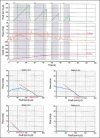The penile cuff test: A clinically useful non-invasive urodynamic investigation to diagnose men with lower urinary tract symptoms
- PMID: 19468441
- PMCID: PMC2684319
- DOI: 10.4103/0970-1591.45549
The penile cuff test: A clinically useful non-invasive urodynamic investigation to diagnose men with lower urinary tract symptoms
Abstract
Objectives: To summarize the development of a novel non-invasive test to categorize voiding dysfunction in men complaining of lower urinary tract symptoms (LUTS) - the penile cuff test.
Methods: The test involves the controlled inflation of a penile cuff during micturition to interrupt voiding and hence estimate isovolumetric bladder pressure (p(ves.isv)). The validity, reliability, and clinical usefulness of the test were determined in a number of studies in men with LUTS.
Results: The penile cuff test can be successfully performed in over 90% of men with LUTS. The reading of cuff pressure at flow interruption (p(cuff.int)) gives a valid and reliable estimate of invasively-measured p(ves.isv) and when combined with the reading for maximum flow rate obtained during the test (Q(max)) produces an accurate categorization of bladder outlet obstruction (BOO). Use of this categorization prior to treatment allows improved prediction of outcome from prostatectomy.
Conclusion: The penile cuff test fulfils the criteria as a useful clinical measurement technique applicable to the diagnosis and treatment planning of men with LUTS.
Keywords: Bladder outlet obstruction; non-invasive urodynamics; urinary symptoms.
Conflict of interest statement
Figures






Similar articles
-
The UroCuff test: a non-invasive alternative to pressure flow studies in adult males with lower urinary tract symptoms secondary to bladder outlet obstruction.Can J Urol. 2015 Aug;22(4):7896-901. Can J Urol. 2015. PMID: 26267028
-
A nomogram to classify men with lower urinary tract symptoms using urine flow and noninvasive measurement of bladder pressure.J Urol. 2005 Oct;174(4 Pt 1):1323-6; discussion 1326; author reply 1326. doi: 10.1097/01.ju.0000173637.07357.9e. J Urol. 2005. PMID: 16145412
-
Variation in invasive and noninvasive measurements of isovolumetric bladder pressure and categorization of obstruction according to bladder volume.J Urol. 2006 Jul;176(1):172-6. doi: 10.1016/S0022-5347(06)00497-6. J Urol. 2006. PMID: 16753395
-
Positioning invasive versus noninvasive urodynamics in the assessment of bladder outlet obstruction.Curr Opin Urol. 2009 Jan;19(1):55-62. doi: 10.1097/MOU.0b013e328317ca9b. Curr Opin Urol. 2009. PMID: 19057217 Review.
-
The role of invasive and non-invasive urodynamics in male voiding lower urinary tract symptoms.World J Urol. 2011 Apr;29(2):191-7. doi: 10.1007/s00345-009-0488-8. Epub 2009 Nov 15. World J Urol. 2011. PMID: 19916009 Review.
Cited by
-
MRI-based radiomic features of the urinary bladder wall identify patients with moderate-to-severe international prostate symptom score.World J Urol. 2024 Jun 13;42(1):375. doi: 10.1007/s00345-024-05081-3. World J Urol. 2024. PMID: 38872048 Free PMC article.
-
Simple Modification of the Bladder Outlet Obstruction Index for Better Prediction of Endoscopically-Proven Prostatic Obstruction: A Preliminary Study.PLoS One. 2015 Oct 27;10(10):e0141745. doi: 10.1371/journal.pone.0141745. eCollection 2015. PLoS One. 2015. PMID: 26505196 Free PMC article.
-
The role of noninvasive penile cuff test in patients with bladder outlet obstruction.Korean J Urol. 2015 Oct;56(10):722-8. doi: 10.4111/kju.2015.56.10.722. Epub 2015 Oct 13. Korean J Urol. 2015. PMID: 26495074 Free PMC article.
References
-
- Boyle P, Robertson C, Mazzetta C, Keech M, Hobbs FD, Fourcade R, et al. The prevalence of lower urinary tract symptoms in men and women in four centres: The UrEpik study. BJU Int. 2003;92:409–14. - PubMed
-
- Homma Y. Pressure-flow studies in benign prostatic hyperplasia: To do or not to do for the patient. BJU Int. 2001;87:19–23. - PubMed
-
- Van Mastrigt R, Pel JJ. Towards a non-invasive diagnosis of bladder outlet obstruction. BJU Int. 1999;84:195–203. - PubMed
-
- Brindley G, Craggs M. The effect of atropine on the urinary bladder of the baboon and of man. J Physiol. 1975:256–55. - PubMed
-
- McRae LP, Bottaccini MR, Gleason D. Noninvasive quantitative method for measuring isovolumetric bladder pressure and urethral resistance in the male: I, Experimental validation of the theory. Neurourol Urodyn. 1995;14:101–14. - PubMed

